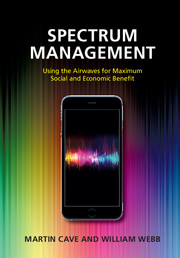Book contents
- Frontmatter
- Contents
- Preface
- Acknowledgments
- Plan of the book
- List of abbreviations
- Part I Fundamentals
- Part II Economic management of spectrum
- Part III Sharing and other emerging approaches to spectrum management
- Part IV Case studies and conclusions
- 11 The struggle for the UHF band
- 12 Public-sector spectrum use
- 13 Spectrum and the wider economy
- 14 Where next?
- About the authors
- Index
14 - Where next?
from Part IV - Case studies and conclusions
Published online by Cambridge University Press: 05 November 2015
- Frontmatter
- Contents
- Preface
- Acknowledgments
- Plan of the book
- List of abbreviations
- Part I Fundamentals
- Part II Economic management of spectrum
- Part III Sharing and other emerging approaches to spectrum management
- Part IV Case studies and conclusions
- 11 The struggle for the UHF band
- 12 Public-sector spectrum use
- 13 Spectrum and the wider economy
- 14 Where next?
- About the authors
- Index
Summary
The challenge for the regulator remains the same as always – to maximize the value of the use of radio spectrum through ensuring that the highest-value users have access to the spectrum and that the interference between them remains controlled to an optimal level. However, the solution to this challenge is constantly changing as usage patterns change and new tools to manage users develop, often based on changing technology. In this final chapter we look at the key trends relating to spectrum usage and suggest where we think spectrum management will evolve in the coming decades.
Trends
Trends in usage
There are hundreds of different uses of the radio spectrum and trends and changes in many of these. However, where the users require relatively small amounts of spectrum, or spectrum for which there is little competition (e.g. satellite use of frequencies above 20 GHz) then these have limited impact on spectrum management approaches. Here we discuss what we believe are some of the most important trends relating to those uses that generate the highest economic value (broadly cellular and broadcasting), those that compete for the most congested spectrum and those where innovation might be most likely to occur. The trends are not presented in any particular order.
Trend 1: growing importance of unlicensed spectrum We are using Wi-Fi and Bluetooth ever more. Home Wi-Fi networks now routinely have tens of devices connected to them whereas a decade ago they might have had one or two. Monitoring devices are slowly appearing around the home, such as Wi-Fi-connected security devices, and many more are being shown at trade shows. Other systems, such as the home energy system, may make use of a separate network within the home to connect gas and electricity meters, in-home displays, and eventually smart appliances. Out of the home we are increasingly looking to log onto Wi-Fi hotspots wherever we find ourselves. Bluetooth accessories are proliferating, with many health- and fitness-oriented devices being developed for wearing and devices like Google Glass being tested. As this usage grows so will the possibilities of interference, while at the same time our tolerance for not being connected will fall. The use of 5 GHz spectrum will offer some relief but regulators may need to become more inclined towards making bands unlicensed than they are at present.
- Type
- Chapter
- Information
- Spectrum ManagementUsing the Airwaves for Maximum Social and Economic Benefit, pp. 252 - 257Publisher: Cambridge University PressPrint publication year: 2015



